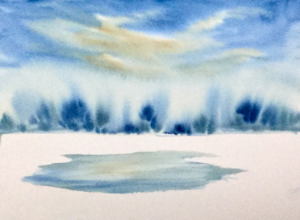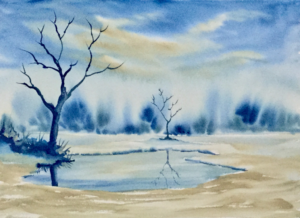
So I don’t get too focused on a particular range of colours that I would normally work with, I sometimes select 2 or 3 different colours I am not familiar with and see how they work together in a painting. It’s pretty usual for me to work with a limited palette for a particular scene, and the wide range of SAA paints offers me many options. However, like many artists, I do find myself working with my favourite colours quite often : Burnt Sienna, Ultramarine Blue, Raw Sienna, Lemon Yellow, Cadmium Yellow, Paynes Grey etc. But I really enjoy the experience of working with other more unusual colours from the SAA range occasionally, which expands my understanding of the paints and how they interact when mixed together – a valuable exercise for any artist.
This is something I also do occasionally in my workshops and classes to help encourage fellow artists and students to understand the extended opportunities that other colours offer. You will see on my website (www.thepaintings.co.uk) that I like to use a wide tonal range and strong colours.
Well I decided to try Phthalo Blue (Red Shade), Sandstone and Neutral Tint (Green Shade) just to see how they work together in a very simple landscape painting.
 Firstly, with an SAA 1 inch flat brush I wet the top two thirds of the paper with clean water, and then added a weak mix of the blue to create a sky with white cloud areas. My experimental drive got the better of me and I added a very weak mix of the opaque Sandstone to the white cloud areas, and was quite pleased with the result. Sandstone is a wonderful creamy beige that is ideal for golden beaches, so why not try it in a sky I thought. Whilst the sky was still wet, I tipped the painting upside down and added trees to the horizon wet-into-wet. Because the sky was still wet, the colour ran down and created wonderful distant trees with nice soft edges. Mixing the opaque Sandstone with the Phthalo Blue gave me a quite attractive light blue/grey colour that worked very well among the blue trees. I then added the pond using the same 2 colours as reflections of the sky.
Firstly, with an SAA 1 inch flat brush I wet the top two thirds of the paper with clean water, and then added a weak mix of the blue to create a sky with white cloud areas. My experimental drive got the better of me and I added a very weak mix of the opaque Sandstone to the white cloud areas, and was quite pleased with the result. Sandstone is a wonderful creamy beige that is ideal for golden beaches, so why not try it in a sky I thought. Whilst the sky was still wet, I tipped the painting upside down and added trees to the horizon wet-into-wet. Because the sky was still wet, the colour ran down and created wonderful distant trees with nice soft edges. Mixing the opaque Sandstone with the Phthalo Blue gave me a quite attractive light blue/grey colour that worked very well among the blue trees. I then added the pond using the same 2 colours as reflections of the sky.
 When the sky and pond were dry, I put the foreground land in with 2 weak layers (dry between layers) of Sandstone, making sure the brush strokes created some undulation as you can see in this picture. Then with a strong blue I added the trees, reflections and grass using a 3mm SAA rigger brush. Before the blue was dry I added a little Sandstone paint to the right hand side of the large tree trunk, and a few sandstone grasses into the blue beneath the tree. The effect was very interesting and added depth and more realism to those areas. You can see that the Sandstone paint really does look like sand, so I will be using it in future for beach scenes.
When the sky and pond were dry, I put the foreground land in with 2 weak layers (dry between layers) of Sandstone, making sure the brush strokes created some undulation as you can see in this picture. Then with a strong blue I added the trees, reflections and grass using a 3mm SAA rigger brush. Before the blue was dry I added a little Sandstone paint to the right hand side of the large tree trunk, and a few sandstone grasses into the blue beneath the tree. The effect was very interesting and added depth and more realism to those areas. You can see that the Sandstone paint really does look like sand, so I will be using it in future for beach scenes.
 The largest tree in the foreground was added using the same technique, painting the tree with the blue and then adding sandstone to create lighter bark (wet-into-wet). You will also notice that some of the branches are sandstone whilst others are dark blue; again this adds interest and depth to an otherwise flat image. You can see that I have also painted grasses at the base of this tree with the same two colours, one after the other and let them mix on the paper. I used a very weak mix of the Neutral Tint (Green Shade) and the 1” flat brush to paint over the Sandstone colour in the distance, which still allowed the Sandstone to show through. You can see the subtle green shade, and through it you can see the sand colour.
The largest tree in the foreground was added using the same technique, painting the tree with the blue and then adding sandstone to create lighter bark (wet-into-wet). You will also notice that some of the branches are sandstone whilst others are dark blue; again this adds interest and depth to an otherwise flat image. You can see that I have also painted grasses at the base of this tree with the same two colours, one after the other and let them mix on the paper. I used a very weak mix of the Neutral Tint (Green Shade) and the 1” flat brush to paint over the Sandstone colour in the distance, which still allowed the Sandstone to show through. You can see the subtle green shade, and through it you can see the sand colour.
Finally to give the painting additional depth I used a strong mix of the Neutral Tint (Green Shade) to darken the foreground bank, leaving a few Sandstone marks in the centre. The dark of the Neutral Tint makes the remaining central Sandstone area look a lot brighter.
Thank you for reading my blog, I hope you enjoyed it and that you feel inspired to try a few different colours from the wide range available from the SAA.
Please visit my website – www.thepaintings.co.uk – where you will find more details about classes, courses, kits and downloadable painting guides. There are some exciting classes and workshops in wonderful locations coming up.
If you are a member of a group and would like a workshop or demonstration please get in touch.
Happy Painting!